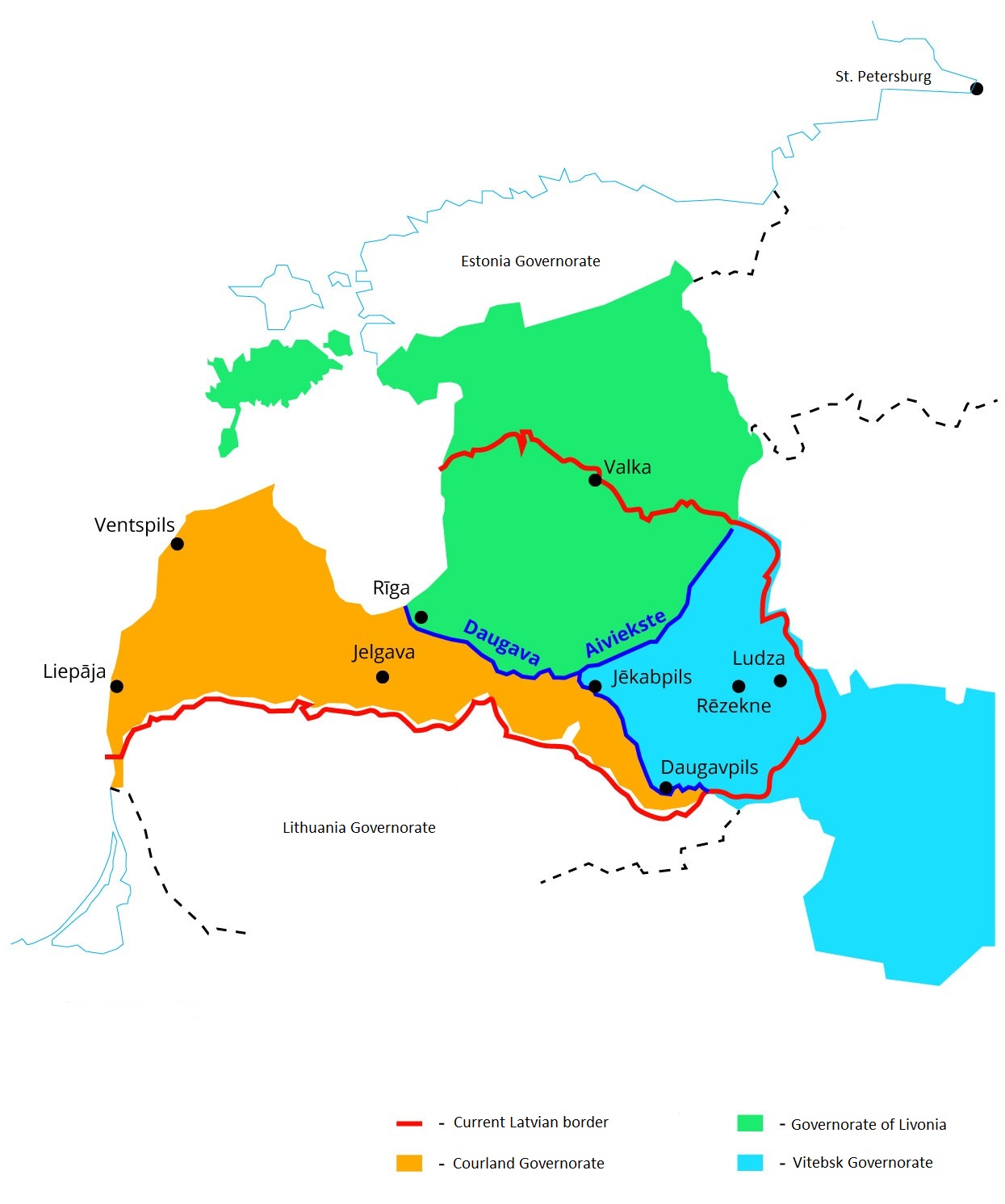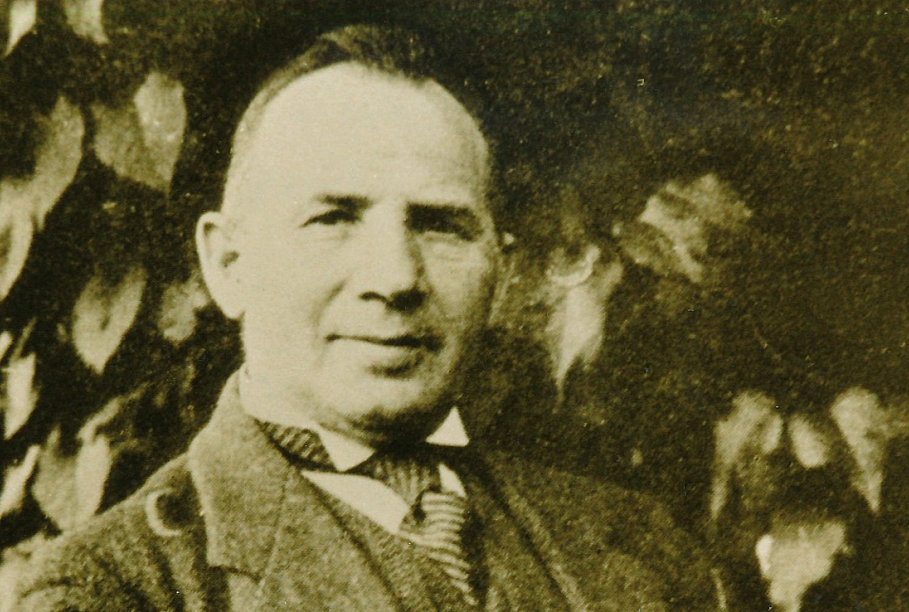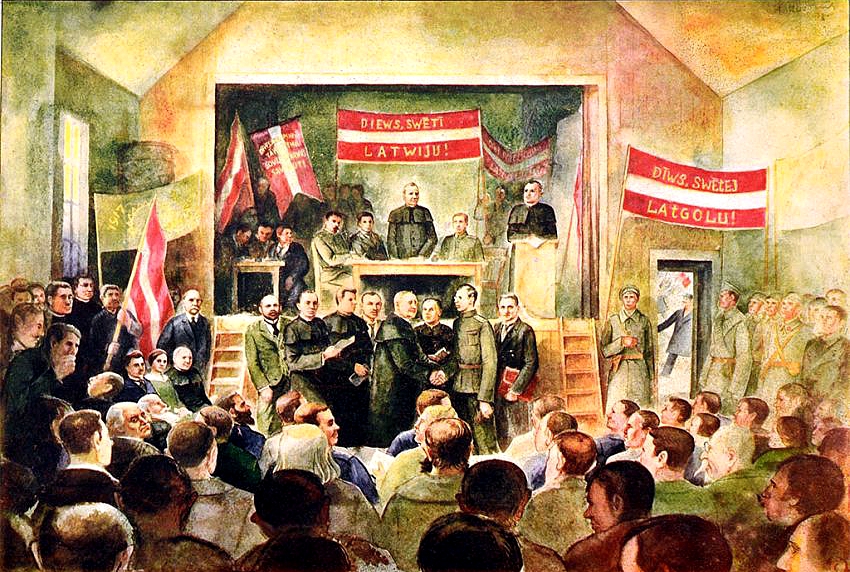Legal and religious divide
For 300 years, Latgale was administratively divided from the rest of Latvia. It was part of the Vitebsk Governorate of the Russian Empire and had different laws from neighboring Courland and Livonia.

Map: Latvia's territory during the Russian Empire
Matters of faith were different in Latgale as well, with Catholics living side by side with Jews, Orthodox Christians, and Old Believers. Then, as now, Latgale had a Catholic majority while the rest of what is now Latvia was mainly of protestant Lutheran faith.
Serfdom was abolished in Latgale only in 1861, about 40 years later than in Courland and the Livonian Governorate.
Latgale was also actively Russified with studies at school allowed only in Russian. From 1865 to 1904 the Latin alphabet was banned, which impaired the cultural development of the region.
Ways to speak Latvian
There are three main Latvian dialects - the Livonian dialect, High Latvian and the Middle dialect. The Latgalian language falls within the High Latvian dialect and is of course mutually intelligible with the other dialects. There are about 165,000 speakers of Latgalian as per the 2011 census. A documentary recently featured on LSM highlights the differences between the dialects.
In spite of the limitations, Latgale managed to retain its particular linguistic character (Latgalians regard Latgalian as a language in its own right, even though it is closely related to Latvian) and children learned to read at home using prayer books.
National awakening
In the early 20th century many Latgalians went to St. Petersburg for work and education. At the time, Latgale did not have a university of its own.
As the locals became wealthier and better educated, a cultural awakening took place. Its early roots were founded in St. Petersburg but later on moved to Rēzekne.
The more progressive and educated Latgalian Latvians set to work by printing books and newspapers in Latgalian, arranged theater performances, sang songs and worked towards improving the local economy.
Similar ideals and ideas disseminated about 50 years earlier in the rest of Latvia finally gained currency in Latgale in the early 20th century.
The Latgalian Musical Association in St. Petersburg became a significant hub for the Latgalian national awakening. It had its own choir, a theater troupe, an orchestra and a library.
The association held clandestine evening discussions on the future of Latgale and Latvia.

The first edition of Gaisma
The first newspaper in Latgalian, Gaisma (Light) was published in 1905 and 1906. Its first edition, published on November 27, 1905, says "Only recently we were simply suppressed and enslaved serfs, we were working people who were subjected and trampled upon by everyone who could do so. But now we're a free folk."
The awakening took on a political shape in 1917, culminating in the First Latgale Congress held on May 9-10, 1917 (April 25-26 after the Julian calendar).
Latgalians recognize their Latvian-ness only with time
Latgalians and the other Latvians only gradually came to a sense of being essentially one folk.
“In everyday life, of course the Latgalians knew who are the Baltic Latvians, and the Baltic Latvians knew who the Latgalians are. But it doesn’t mean that there was a sense of unity, of belonging to a whole, a single nation. This sense came only gradually. It could even be surprising how late this awareness came to be,” said Toms Ķikuts, an expert at the Latvian National History Museum.
“For example, the first Latvian-language maps were made in the 1850s and 1860s. In them, the Courland and Vidzeme parts of the Baltic Governorate are described as ‘Latvian lands’, but not Latgale,” he said.
People called themselves Latvian in Vitebsk, Courland and the Latvian-speaking part of the Livonian Governorate (now Vidzeme). However, they had other names for the people living across the River Daugava.
Latgalian Catholics called themselves both Latvian and Latgalian, but called those living in the other governorates ‘Balts’, pārnovadnieki (people from other districts) and čiuļi (derogatory).
Meanwhile those living in Courland and Vidzeme called Latgalians ‘Vitebskians’, ‘Inflantians’ and čangaļi (derogatory).
A sense of unity arose only over time. As late as 1915 Latgalian newspaper Drywa proclaimed that, “To put it short, we’re Latgalians and they are Balts, but both sides put together are Latvians.”
Cultural luminaries did much to inspire a sense of unity. Chief among them was political leader Francis Trasuns (1864 – 1926), a member of the Russian State Duma and later of the Latvian Saeima.

Francis Trasuns
He often lectured at the Riga Latvian Society, becoming something of a Latgalian ambassador to the rest of what was to become Latvia. Trasuns lectured on the religious and linguistic differences between Latgalians and the other Latvians, calling for friendly relations and encouraging a sense of unity among Latvian speakers.
“We view one another as foreigners, as adversaries. But who needs that? Certainly we Latvians don’t need that. We are all a single Latvian folk. Let’s all do that which brings us closer together and unites us,” he wrote in 1907.
He also called for Latvians and Latgalians to use a unified alphabet based on Latin letters.
During the early 20th century and the First World War the barrier between the two parts of the Latvian folk started dissolving.
February revolution leads to Latgale Congress
The February Revolution in 1917 brought sweeping democratic changes to what was the Russian Empire, with the introduction of political freedoms and freedom of speech. Latgalians used the circumstances to unite with the rest of Latvians.
In March 1917, preparations for the Latgale Congress began in St. Petersburg, with a group of Latgalians living there putting the fate of Latgale to vote.
Francis Trasuns’ ideas about the future fate of Latgale gained favor. He campaigned for uniting with the other districts of Latvia while remaining a part of Russia. Another man named Francis – Francis Kemps – preferred autonomy for Latgale (he also came up with the current name of the region) as part of Russia, but his ideas were rejected.
No one knew back then that the Bolsheviks would take over Russia soon. Latvia’s independence was certainly not on the agenda yet.
The meeting in St. Petersburg arranged that the Latgale Congress would take place in Rēzekne..jpg) Rēzekne in 1928. Photo: Latgale Cultural History Museum
Rēzekne in 1928. Photo: Latgale Cultural History Museum
The congress would discuss matters pertaining to Latgale’s self-government, as well as leaving the Vitebsk Governorate and joining other Latvian-speaking parts of Latvia.
Catholic priests played a large part in organizing the congress with the organizers finding delegates in parishes, associations, and Latvian riflemen.
232 delegates and 118 guests attended the congress, including Zigfrīds Anna-Meierovics, who became a renowned Foreign Minister during Latvia’s first independence.
Latgale Congress marks decision to unite Latvians
The Latgale Congress was something of a ruckus. On the first day no decisions were made as there was very heated debate. Several supporters of Francis Trasuns had left Rēzekne before the congress ended, because his delegates had been attacked.
The memoirs of the participants describe one delegate being thrown into the River Rēzekne, as well as one priest who was hit with a rock and another one who was beaten with a stick.
However on the second day the decision to unite with Vidzeme and Courland was adopted with 43 delegates voting for and 23 against.
 Delegates at the Latgale Congress. Photo: Latgale Literature Museum.
Delegates at the Latgale Congress. Photo: Latgale Literature Museum.
Latgale today
Latgale is a vibrant cultural center with Daugavpils, Latvia's second largest city housing the impressive Mark Rothko Center. While Rēzekne, often called the capital of Latgale, is home to the stunning 'Gors' cultural centre that styles itself the 'Latgale embassy' and could give any avant-garde Scandinavian opera house a run for its money.
Latgale has always retained its own particular identity, based on its parallel history that offers a mix where Orthodox, Catholic, Lutheran and Jewish traditions all co-exist. The beautiful region is known for its bodies of water and is poetically referred to as the "land of the blue lakes".
The second article discussed linguistic autonomy and is of particular historic importance to Latgalians.
The Provisional Land Council of Latgale was set up in the congress, tasked with achieving separation of Latvian-inhabited lands from the Vitebsk Governorate and uniting them with the Baltic provinces of Courland and Vidzeme.
“The Latgalian Congress is the beginning of the Latvian state. It’s the dawn of independence. It shows that the Latvian state sprung up with great determination. Gradually, from one stage to another, the road to independence was paved,” said Heinrihs Soms, a professor at Daugavpils University.
In 1920, following the Latvian War of Independence, Latgale was incorporated into Latvia by the peace treaty with Soviet Russia.



























